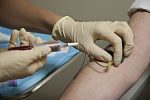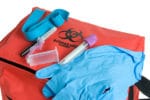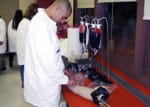What Does a Typical Day on the Job Look Like?
But a phlebotomist is rarely just required to know how to collect a patient’s blood. It almost always also involves working with coworkers and computers. It often involves working with people that are terrified of needles, including children, and requires a clean and organized personality.
Typical Daily Duties
We surveyed dozens of phlebotomist jobs to summarize the most common skills. This way, you can get a general idea if this is the type of job you think you can do. Now, there was no single job that had all, or even most of these requirements, but these tended to show up most often:
- Draw and label blood samples, including venipuncture and finger stick, from arterial, capillary, and venous locations.
- Collect and label urine samples
- Follow policies, SOPs (standard operating procedure), regulatory guidelines, safety and cGMP requirements.
- Register patients
- Review patient records for accuracy
- Perform donor physical exam such as temperature, blood pressure, Hgb/Hct and pulse.
- Deal with adverse (bad) reactions, hematomas or injuries, and is able to make necessary adjustments.
- Work under supervision
- Maintain clean and healthy work environment
- Maintains a clean and orderly work area.
- Monitor storage and inventory of supplies
- Label and/or ship specimens to laboratories as needed
- Have general computer knowledge and data entry (you usually do not need to know MS Office programs though)
- Maintain patient files and records
- Greet, and communicate with patients to make sure they are calm and comfortable.
Some jobs may require more office duties than others like scheduling appointments, but it was not a common duty. Otherwise, expect your typical office job requirements like having a positive professional attitude, and being able to communicate and work well with others.
It probably goes without saying that many employers also require a drug-free workplace, so don’t be surprised if some test you for drugs now and then.
Hours of a Phlebotomist
Surprisingly, in our sampling of dozens of phlebotomy jobs, fewer than 5% listed work hours. Some of the jobs are 9 to 5 (e.g. dedicated lab, plasma donation, clinic, etc..), but many hospital positions are often going to include weekends, evenings, and holidays. However, in general, employers tend to offset this inconvenience with slightly higher pay, so if you don’t mind working late for some extra income, this is a consideration.
Senior (a.k.a. Supervisory or Lead) Phlebotomist Jobs
These roles pay more, but they always require more experience, accountability, and human management skills than an entry or standard phlebotomist. We sampled several such jobs and found these common requirements:
- Collaborates with leadership
- Works to train phlebotomists within job, oftn times designing and implementing training programs.
- Provides leadership
- Present findings to management
- Accountable for operations of the area
- Maintain compliance with regulatory guidelines (e.g. OSHA, CLIA, cGMP )
- Supervises donor files and machine logs (e.g. PCS-2 machine logs)
- Operates and maintains the automated plasmapheresis machines
- Maintain
- Supervise donor reactions
- Monitor and maintain inventories
So, looking at the same sample set of about 500 job listings, Indeed estimated that most paid in the $30k range, and in expensive cities like in California, Texas, and New York, the pay is in the $50k+ range, but you can check our guide about salary for more details,
Phlebotomy Job Descriptions by Type, Location, or Specialty
A phlebotomists exact duties can vary depending on the type of work they are doing. Here are a few of the more common ones:
Plasma Center or Blood Bank
Donation centers are going to be quite similar to a regular phlebotomist job, but with some variations. Here are a few of the common ones we found:
- Interview donors to see if they will be good candidates (because many people are not allowed to donate even if they want to).
- Watch for signs of anxiety, illness, fatigue, and uses interviewing skills to elicit honest and complete answers from donors. Again, because they do not need to donate, and these take a long time, this is a little more demanding than a regular blood draw.
- Discuss any abnormal findings with patient found in their history.
- Respond to donor questions without giving medical advice
- Help with recruiting and retaining donors
- Maintain confidentiality at all times.
- Wear appropriate attire and have good grooming standards.
Hospital
In sampling several hospital jobs, there was almost no variation, except for the needed hours. We noted a couple with interesting requirements like being able to work with the difficult blood draws, since nurses are likely to take care of the easy ones in places like an ER.
Lab
A lab can be of two types: A blood draw lab, or a processing lab, although most of the processing labs required more training than a standard phlebotomist.
Traveling, Mobile, or Floater Phlebotomist
There are all different terms to mean essentially the same thing. A traveling phlebotomist is unique in that traveling is part of their daily routine.
Usually, you will need a valid driver’s license, and sometimes even a reliable vehicle (and car insurance of course) to travel in if they do not provide you with a company car. Traveling can include moving between different facilities within an organization, traveling between blood drive stations, and between hospitals.
Sometimes this position can even include overnight travel as well.
Pay is sometimes on a per case basis (e.g. $15 – $42 according to one job description I read), so this ensures you are getting paid on your productivity, instead of just getting paid to show up. Kind of like a taxi driver, but hopefully you aren’t cutting corners like one.
Outpatient Phlebotomist
There was no noticeable difference in an outpatient phlebotomist. Outpatient care is basically any care that is not in a hospital (or overnight). So this can include clinics, doctor offices, plasma centers, senior centers, and even surgical centers if the patient is not staying overnight.
Forensic Phlebotomist
A forensic phlebotomist works with law enforcement to collect samples from suspects for use as evidence, often used in criminal court cases. It can range from, most commonly, DUI’s and drug use, as well as major crimes of assault and homicide. Like typical phlebotomist jobs, a forensic phlebotomist is often “on call.”
Phlebotomy jobs can also be located in places such as
- nursing homes,
- long term care centers,
- drug rehab centers,
- psychiatric facilities,
- mental retardation facilities
How Does Being a Phlebotomist Compare to Being a Nurse?
First off, you should know that many phlebotomy skills often fall under the job of a nurse, as a nurse requires far more training.
So, being a nurse is going to obviously have a lot more variety in their duties, as well as significantly more training compared to a phlebotomist. A nurse is going to have numerous types of illnesses and diseases to work with versus a phlebotomist who just draws blood all day.
How Many Part of Full Time Phlebotomy Jobs are Available?
We did an analysis using Indeed and from over 10,000 jobs, this is the breakdown.

- Full time 74%
- Part time 20%
- Temporary 3%
- Contract 3%
So while it does appear there is a health amount of full and part time positions available, there are very few temporary and contract jobs, which is probably not a problem for most job seekers in this field.
What Personality Traits Are Needed?
Sometimes it’s ideal to know what the most common requirements are, so we looked at LabCorp requirements. They are one of the largest blood draw labs in the USA. Check out the traits below (scale of 1 – 10) to see if you have the right combination of talents.
- Adaptable 7
- Compassionate 10
- Collaborative 8
- Detail-oriented 7
- Patient 8
- Quick-thinking 7
Additional Recommended Traits
- Positive
- Trustworthy
- Fast-paced
- Multitasker
- Assertive
Even if you don’t possess some of these traits naturally, remember that:
- These traits are only required while on the job, not at home.
- They are usually not required traits–just suggested, so many people are not going to have all of these skills at the desired target levels.
- With effort and training, you can learn and improve many of these skills, just like any other skill.
Notice the most important skill is to be “compassionate” which means to be understanding of patient’s needs, concerns, and pain. Chances are, you will frequently deal with patients that are nervous, or even terrified about getting a needle in their arm, so knowing how to calm them is a valuable trait.
If you are not compassionate, Labcorp may not be your thing, but there are other companies that hire phlebotomists that don’t require these same traits.
Sample Job Description (PDF)
Here is a sample job description in PDF format that you can save to your computer:






